
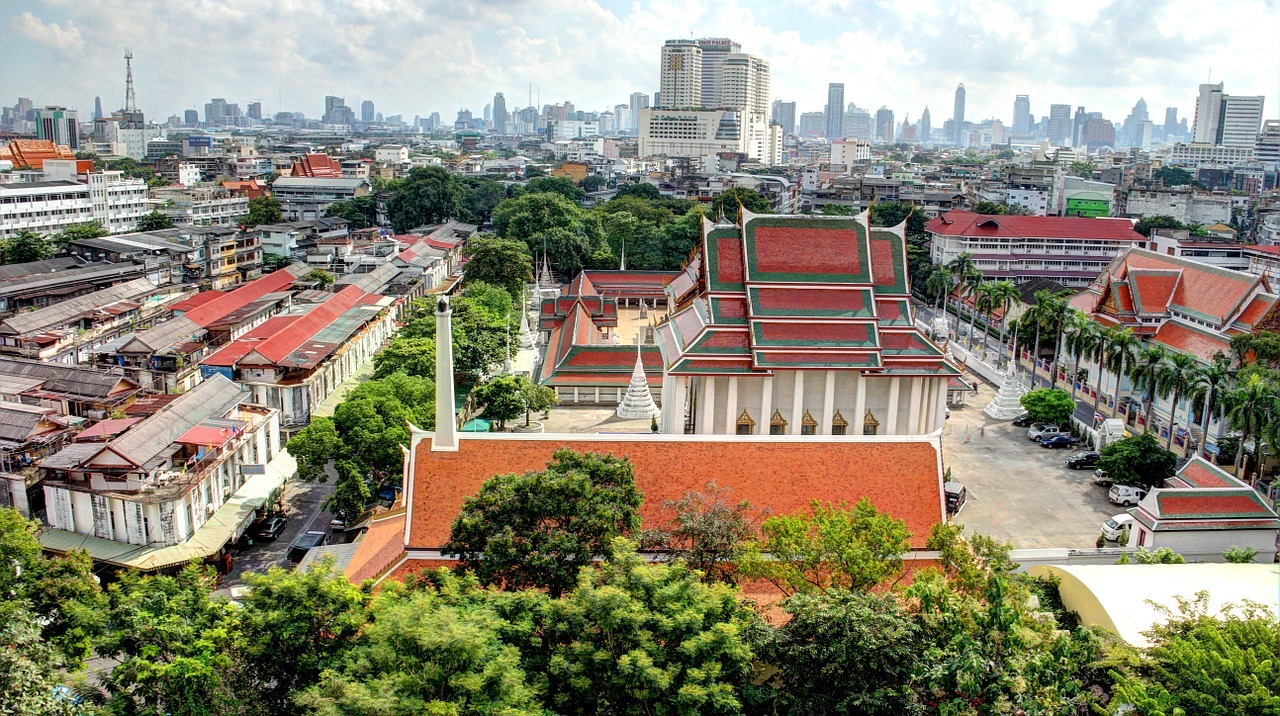
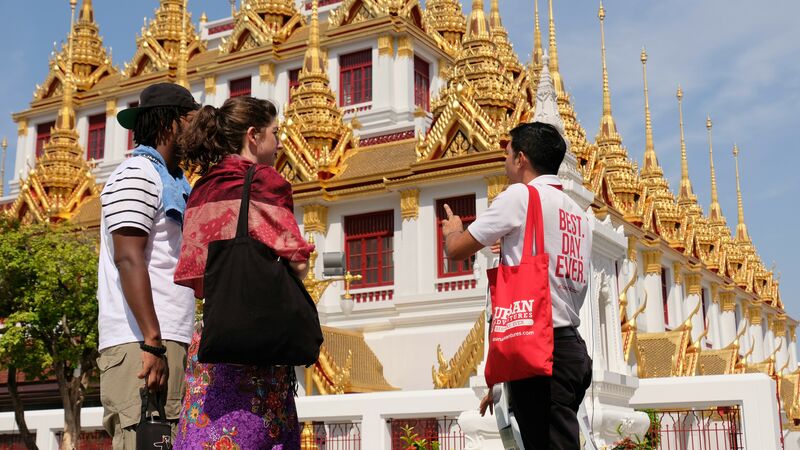
Bangkok’s most popular temples are popular for good reason, they are spectacular and almost every visitor to Bangkok will visit the top three: Wat Pho with its famous reclining Buddha, Wat Phra Kaew at the Grand Palace and Wat Arun, the Temple of Dawn. But the city has more than 400 temples, and many that have unique features, so if you’d rather enjoy a peaceful escape visit one of these quieter but still magnificent temples instead:
Wat Ratchanatdaram and Loha Prasat
Despite its location next to the well-known Wat Saket (The Golden Mount), Wat Ratchanatdaram is something of a hidden gem in the city. Built in 1846 during the reign of King Rama III, Wat Ratchanatdaram is best known for Loha Prasat. This very Instagrammable sight is a 36-metre-tall, multi-tiered structure featuring 37 metal spires, signifying the 37 Buddhist virtues toward enlightenment. Only three similar constructions ever existed in the world, and only this one in Bangkok is still standing.
We visit the local Amulet Market in this temple’s grounds on our Tuk Tuk Experience
Wat Ratchabophit
This unique, historic temple is just one block away from The Grand Palace, Wat Phra Kaew and Wat Pho across a small khlong (canal) which forms part of the original old city moat. It was built by the King Rama V in 1869 with an unusual layout featuring a 43m tall gilded chedi (or stupa) at the centre of a circular courtyard with tiled cloisters. This is one of Bangkok’s most beautifully decorated temples and yet you’ll see few visitors here. Its interior was inspired by the Italian architecture seen by King Rama V on his trips to Europe and the exterior doors feature watchmen with a very European style which perfectly exemplifies the interest in Western culture that was running through Siamese high society at the time.
We walk through this temple on our Old Bangkok Back Street Food Walk
Wat Suthat and the Giant Swing
This first-class royal temple is one of Bangkok’s oldest, biggest and most impressive – it took 40 years and three King’s to complete, and yet today it’s a little visited hidden gem. It’s only a short distance from The Grand Palace and Wat Pho, but most visitors only pass by to look at the iconic Giant Swing (Sao Ching Cha) that stands at its entrance. The swing pre-dates the temple and was once used in a traditional Brahmin ceremony.
Inside the temple you’ll see Chinese statues that are believed to have been brought as ballast by Chinese trade junks, but the real highlight here is the Viharn (prayer hall) which holds a 14th Century Buddha surrounded by some of Bangkok’s finest murals, the largest murals in the country. The door panels are superb examples of Thai wood carving with one of the doors carved by King Rama II himself (although the original is now housed in the National Museum). The temple also boasts the largest ordination hall in the country and holds the largest bronze Buddha image in Thailand, which is actually made from old opium pipes! This is our guide A’s favourite temple to bring visitors to as there are so many stories to tell and features to share. It’s rare to see such fine examples of Thai Buddhist art outside a museum. Admission 100 THB
We visit this temple on our Bangkok by Bike tour
Discover more: Simple Guide to Temple Etiquette
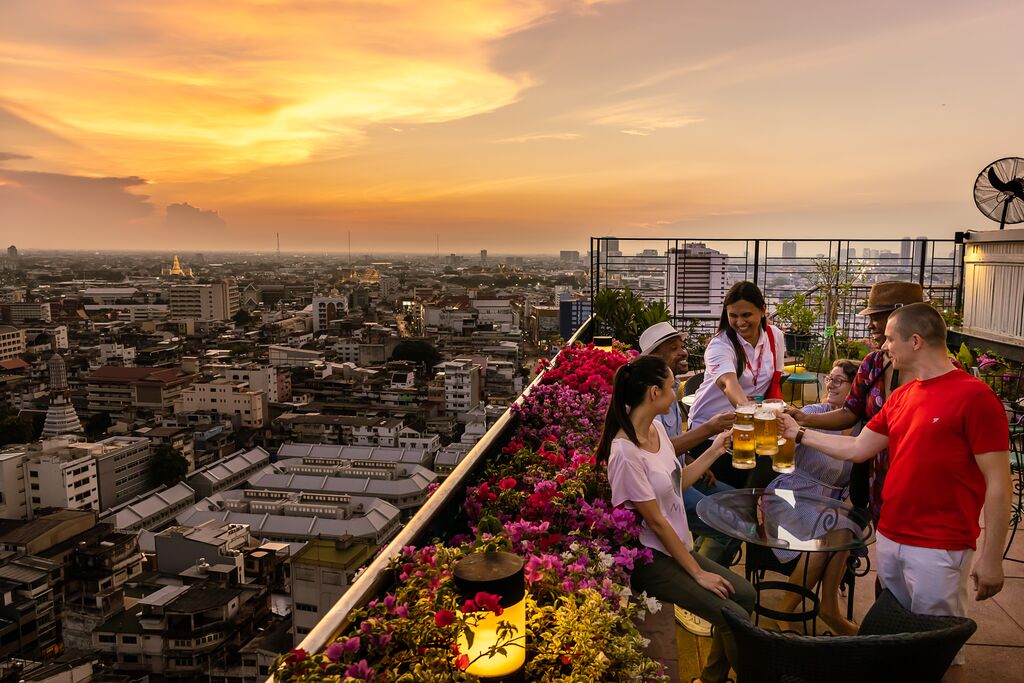
Bangkok is a city of contrasts, there are skyscrapers and modern malls sitting side by side with traditional temples and shrines. The sheer scale of the city can be a surprise to many visitors and there’s no better way to take it all in than from a sky bar as the sun sets.
Bangkok probably has more rooftop bars than any other city, Skybar and Sirocco at Lebua State Tower and Vertigo and Moon at The Banyan Tree have long been at the top of most visitor’s lists. The views are spectacular – but prices are high and dress codes strict (from 800 THB for a cocktail, no flip-flops or shorts).
Mahanakhon Skywalk is the highest observation deck in the city and even has a glass bottomed platform if you’re brave enough to walk on it. You can enjoy a cocktail here while you take in the 360° cityscape for a more reasonable price (around 450 THB) but you’ll also need to buy the observation deck ticket (1050 THB).
The views at all three of these spots are arguably the best in the city so of course crowded at times, if you decide to go we suggest making the most of it by going around an hour before sunset and stay to see city light up as it gets dark.
But if the dress codes, high prices and crowds put you off here are three great alternatives that are a bit less busy, a bit more affordable but still have a fantastic city views.
Skyview 360 at The Grand China Hotel
This is our favourite skybar in Bangkok, whilst it’s not the highest one in town, its location in the old part of the city means you get a much better view of Bangkok’s most famous historic monuments from here than from other rooftops.
From the restaurant level you can see a full 360° and easily spot The Golden Mount, Wat Arun and the Grand Palace. We prefer to sit one level lower for a drink in the open air looking towards the Chao Phraya River in the perfect spot for sunset. From this side you’ll see Mahanakhon Skywalk and Icon Siam and the rooftops of Chinatown. Drinks here are great value for a sky bar and there’s no dress-code. Get here for happy hour (between 5 and 7pm) for a beer or cocktail under 250 THB. Take the lift directly to the 25th floor and once you’ve looked all around walk down one level to the open-air river view bar.
We end our Chinatown Sights and Bites tour here
Three Sixty Lounge at Millenium Hilton
This is a hidden gem of a skybar, it’s located right next to the Chao Phraya river, and its river view towards the old city is unbeatable. Perhaps having to cross the river is why more visitors don’t come, but it’s really very easy. The hotel has a free shuttle boat from Sathorn Pier by Saphin Taksin BTS station. The hotel’s position gives its rooftop bar a unique perspective of the Chao Phraya river snaking through the city and you can see all of Bangkok’s most famous historic monuments: Wat Arun, Wat Pho, The Grand Palace, The Golden Mount and if you know which direction to look you can see the bright lights of Yaowarat Road (Bangkok’s Chinatown), Wat Traimit and Bangkok Hua Lamphong Railway station as well.
This bar is on the 32nd floor of a 5 Star hotel so smart casual dress is appropriate and the bar prices are as you’d expect (cocktails start at around 550 THB) but the cocktails are generous. Open from 5pm.
ZOOM Sky Bar at Anantara Sathorn
This is our guide Sasha’s favourite Skybar for a special night out with her friends, she likes the fact that it’s not as well-known as others so a great place for a group to hang out together with an incredible view over the city.
Zoom is in the same district as Skybar/Sirocco and Vertigo/Moon, and while it doesn’t boast the same height, (it’s on the 40th floor about twenty floors lower than them) it does boast impeccable service, tempting bar snacks, a 360° view and after dark there’s a DJ creating a great atmosphere. We like to sit facing the river towards Bang Kra Chao – known as the green lung of Bangkok – while the sun sets behind us.
The hotel is a short walk from Chong Nonsi BTS station, take the lift in the East Tower to the top floor. Open from 5:30pm, drinks from 375 THB, bar snacks from 280-450 THB including taxes.
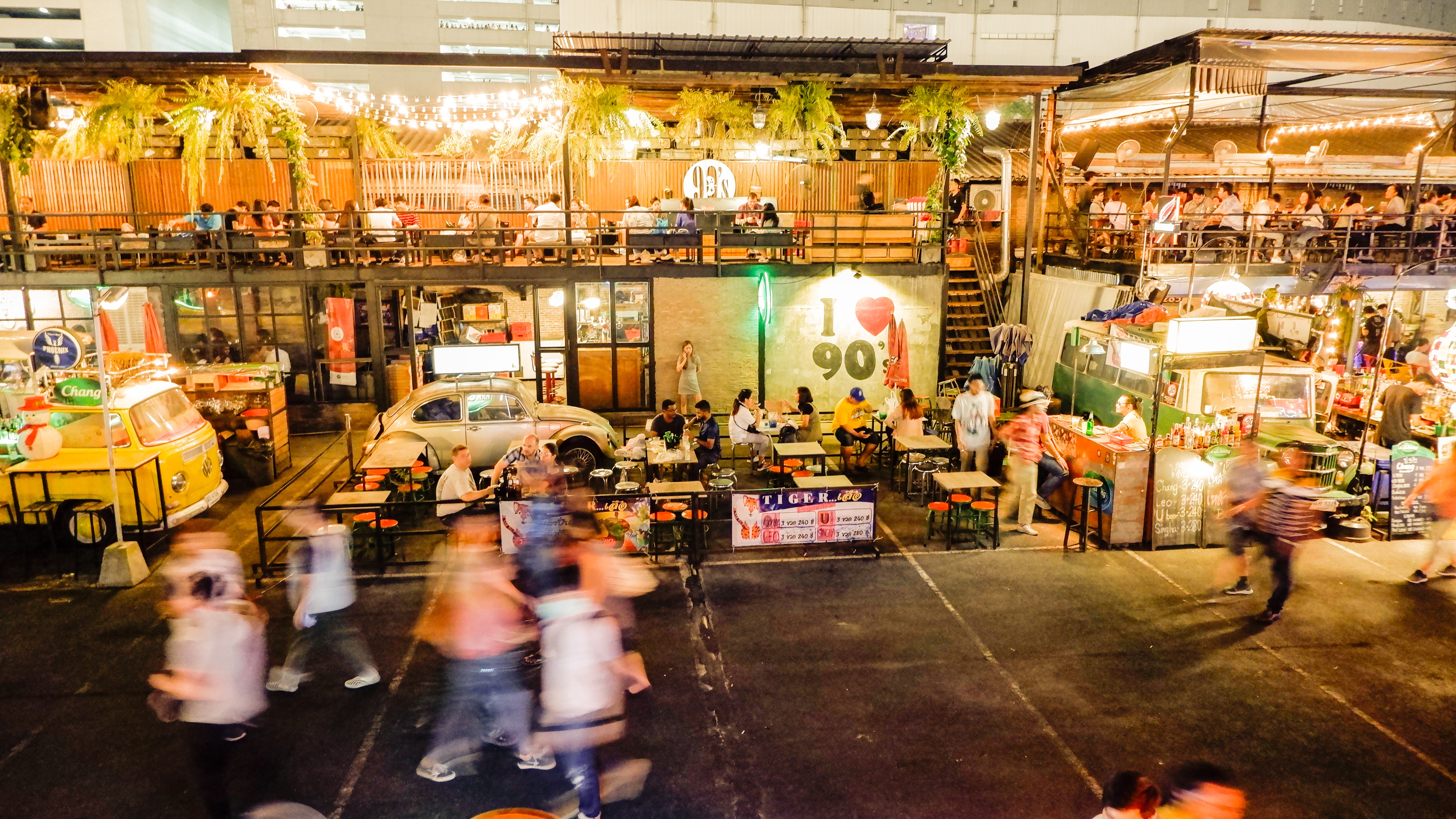
Bangkok’s is famous for its shopping, and visitors are attracted to the city from all over Asia just to hit the malls and markets. Spending an evening at a night market is a quintessentially Asian experience, we love the combination of shopping, eating and drinking for a family or groups of friends to get together. Bangkok’s most famous and most visited night market is Rod Fai Ratchada, partly because it has a good balance of all three essential elements, and because it’s open daily (from 5pm) in an easy to reach location next to Thailand Cultural Centre MRT station. It draws big crowds of tourists every night, but there are other options if you’d rather rub shoulders with some locals, especially if you’re in Bangkok at the weekend.
Rod Fai Srinakarin
This is the big brother of Rod Fai Ratchada and far more locals than tourists tend to visit. It has more than 2000 stalls and shops with a section dedicated to antiques, lots of vintage and collectable goods as well as the more typical clothes, accessories and homewares. There’s no shortage of bars and street food with the best atmosphere on a Saturday night when the locals tend to go. The downside is it’s a bit out of the city centre next to Seacon Square Mall in the east of Bangkok, so you’ll need to take a taxi – and with Bangkok’s infamous traffic congestion you’ll probably need to allow an hour for the journey. It’s not open every day, but if you’re here at the weekend we think it’s worth the journey for a more unique, local experience. Open Thur-Sun from 5pm
Art box
This small night market started as a pop-up event moving around different locations in the city but has recently had a more permanent position between BTS stations Nana and Asok at Chuvit Gardens on Sukhumvit Road. We’re waiting to see if they’ll stay on or be on the move again, check for updates on their Facebook page. If it stays still, it’s an easily accessible low-key downtown alternative to Rod Fai Ratchada. It’s open daily but at weekends you’ll find more locals out and about and the atmosphere livelier. There are often live bands and performances here, but overall a more chilled than party vibe. The shopping is more sustainable and original than at Rod Fai Ratchada (you won’t find any tacky souvenirs here) as the focus is on local Thai designers and artists, so on the whole not as cheap but still affordable prices that appeal to a younger local audience. There are bars and plenty of both Thai and Western food options as well so if you’re staying nearby it’s worth a visit. Open from 4pm daily.
Chang Chui Creative Park
Also known as the plane night market as it has a disused airplane at its centre. This eclectic creative park features huge sculptures, street art and its buildings are all upcycled – if you want to see something truly unique, and hugely Instagrammable, this is the place to come. It feels more upmarket than Bangkok’s other night markets due to the boutiques and “lack of pile it high, sell it cheap” souvenir stalls, but many of the items for sale at the stalls are just as affordable as elsewhere. There are fine dining options – such as Insects in the Backyard, (yes that’s right, insects in a fine dining establishment!) as well as very reasonably priced outdoor bars and food stalls with regular live bands and events.
Sadly although it’s open daily it just doesn’t seem to be able to attract enough visitors to give it a great atmosphere midweek so we recommend it on a Saturday night and although it’s open during the day as well we’d suggest not going until after dark for the same reason. It’s location on the Thonburi side of the river is probably the only thing that limits its appeal, but if you’re coming from the old city or riverside, it’s an easy taxi ride. From other parts of the city we suggest taking the BTS to Bang Wa or MRT to Bang Phai and a taxi from there. It might look closer to Victory Monument BTS on a map but trust us the traffic is better on the Thonburi side of the river. Open daily from 11am but best on Saturdays from 5pm.
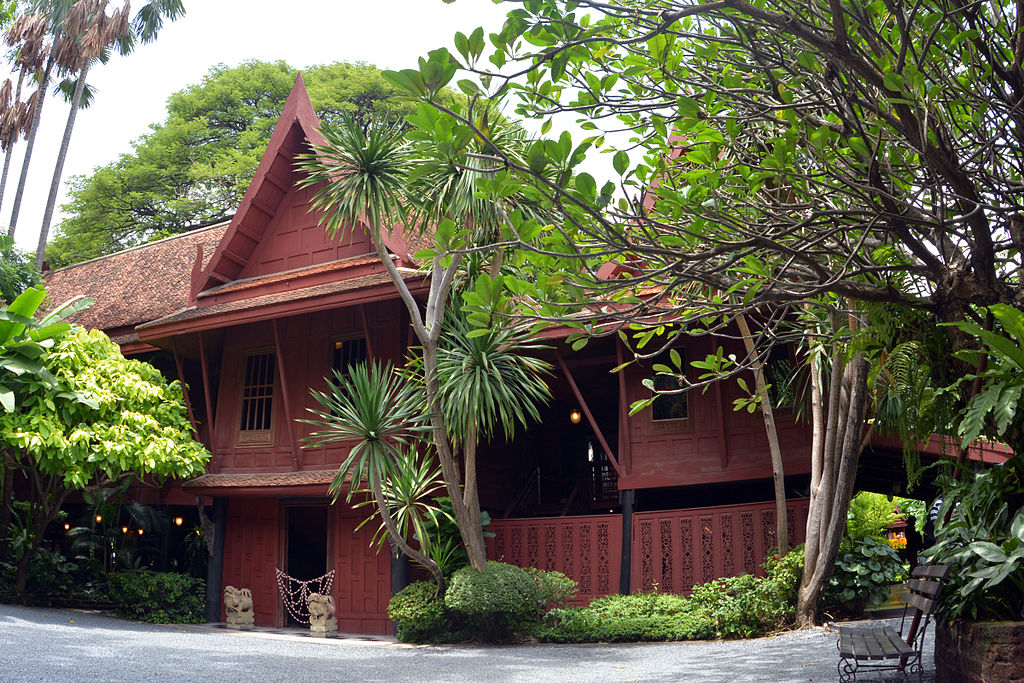
One of the most well-known museums in Bangkok is Jim Thompson’s House. There are a few reasons to visit, firstly to learn the story of the former CIA officer who revitalized the Thai silk industry before mysteriously disappearing in the Malaysian jungle. Secondly to see his beautiful home, made up of a series of traditional Thai wooden houses filled with his collection of antiquities from all over Asia, and thirdly to see and/or buy one of the silk scarves from what is now one of Thailand’s leading luxury brands.
Whilst we can’t match the intrigue and fascination of Jim Thompson’s story elsewhere, we can point you in the direction of three alternative traditional Thai house museums with their own antiquities on display that you’ll have almost to yourself rather than elbow to elbow with other city visitors.
M.R. Kukrit Heritage Home
This is the closest thing in Bangkok to Jim Thompson’s house but with far fewer visitors – there’s a good chance you’ll get to wonder around the beautiful gardens and pavilions virtually by yourself.
M.R. Kukrit was a writer, lecturer and politician who spent 20 years putting his home together sourcing and reassembling traditional houses from all around Thailand around the same time as Jim Thompson was doing his, although it took him 20 years to complete the cluster of teakwood houses and connect them. The tropical gardens and ponds create a tranquil retreat in the middle of this bustling city.
Registered as a site of historic significance by the department of fine art, this is an impressive, but somehow still intimate feeling home. Kukrit collected Thai art and was passionate about the traditional culture and throughout his home you’ll see some of his collection of ceramics, pottery, woodcarvings and paintings as well as signs of everyday life in the bedroom, kitchen and family shrines. He left instructions that the house be opened to the public when he passed away in 1984 and it still feels more like a home more than a museum.
Open daily 10am-4pm, admission 50 THB. Located about a ten-minute walk from Chong Nonsi BTS station off Soi Phra Phinit
Suan Pakkad Palace
This collection of traditional Thai houses was put together by Princess Chumbhot to house her collection of art and antiquities, and opened to the public in the 1950’s not long after it was completed. The Princess believed that although they may be in private ownership, rare and unique artefacts should be accessible to all who wanted to see them. The collection includes pre-historic pottery, fine porcelain, Thai puppets and Khon masks as well as household items and Buddha images. The teak houses are set in a lush green garden, nestled between the trains and the busy road – an urban oasis. The highlight is without doubt the 17th century Lacquer Pavilion that was brought to the palace from a temple near Ayyuthaya and restored in 1959 for the Princess’s 50th birthday present. This building is a treasure of Thai architectural achievement, it doesn’t look so special from the outside, but the interior gold on black lacquer paintings are exquisite, as are the wood-carved panels with fine detail depicting the life of Lord Buddha and stories from the Ramakien. When we visited there were only a handful of tourists here and the museum staff were happy to guide us around parts of the museum and answer all our questions.
Open daily 9am-4pm, admission 100 THB. A 5 to 10-minute walk from BTS Phaya Thai along Phaya Thai Road.
Kamthieng House
This 160 year old Lanna Thai teak house was given to the Siam Society in 1963 by a descendant of the original owner and is a great place to spend an hour or so learning about traditional Lanna culture, especially if you don’t have a chance to visit the north of Thailand. The displays and information are well presented and cover all aspects of the culture from rituals and ceremonies to fishing, weaving and farming. It’s location right in the middle of downtown Bangkok makes it easily accessible and a good option if you just have an hour or so spare.
It’s located just a 5-minute walk from Terminal 21 Mall by BTS Asok/MRT Sukhumvit stations on Sukhumvit Soi 21. Open 9am-5pm daily. Admission 100 THB
If you’re interested in seeing Jim Thompson silk you’ll find stores in many of Bangkok’s more upscale malls and at the airports, or if you want to pick up a designer silk scarf at a bargain price, then head to the Jim Thompson Factory Outlet Store, a short walk from Bang Chak BTS station.
For a very small silk selection but a very local experience, cross the khlong (canal) behind Jim Thompson’s house via the pedestrian bridge and visit one of the original Jim Thompson silk factories in the Ban Krua community. You’ll see a simple local home, filled with silk weaving paraphernalia and maybe even meet the owner who worked for Jim Thompson as a boy. He’s in his 80’s now but has enough words of English to tell you the basic story and show you a picture of him with Jim Thompson himself. If you’d prefer a guided visit contact us and we can include it on a create your own itinerary.

Visiting a floating market is one of the most popular things for visitors to do, but most of them are only open at weekends (because that’s when local people have time to go!) and the biggest most famous daily market is a 1.5 to 2 hour drive out of the city and of course gets pretty busy with tourists. So, if you’re short of time but still want to get a sense of why Bangkok was once known as the “Venice of the East” spend a bit of time on the river or khlongs (canals) instead. You can even use them to get around the city while exploring other sights.
Chao Phraya River Hop on Hop Off Boat
This river service isn’t a hidden gem as such, but it rarely gets too busy and is a convenient and comfortable way to travel between some of Bangkok’s popular areas for visitors while getting a river breeze and a great view.
Usually we’d suggest travelling like a local, but when travelling along the Chao Phraya we prefer the tourist boat. The local boats are cheaper, but very crowded and you’re lucky to get a seat, luckier still if you get to see the view of both riverbanks. With the hop on hop boat there’s a lot more space and from the open roof deck you can see all the key historic places you pass by and you won’t miss anything as there’s announcements with information about each stop. The boat runs between Sathorn Pier (where it meets the BTS Skytrain system at Saphin Taksin) and Phra Artit pier near Khao San Road with stops near Chinatown, Pak Khlong Talad – the Flower Market, Wat Arun (for Wat Pho) and The Grand Palace, all of which are great spots to explore more of the old city as well. We suggest hopping off at Lhong 1919, a Sino-Siamese heritage house turned street art gallery and boutique shopping space, then use the local ferry to cross to Chinatown and continue exploring from here
Boats run from 9am-9pm leaving every 30 minutes in either direction. Single ticket 60 THB or 200 THB for an all-day pass.
Saen Saeb Canal Hop on Hop off boat
In the past Khlong Saen Saeb has been known as the dirty and dangerous route between the old city and downtown Bangkok, only for the brave whether local or visitors. The relatively unknown launch of a Hop on Hop off service, and some clean-up efforts have made it a more visitor friendly option now. The local boats barely stop at the piers with little information to tell you where you are so you have to be ready to jump (sometimes literally as they drift away from the pier as you’re disembarking!) but with the hop on hop off service you get a great map, the stops are clear and better still they really stop! The boat runs in a loop between Pratunam Pier in the Siam area close to the Erawan Shrine and Sukhumvit Malls, all the way down to Phra Sumen Fort where you can connect with the Chao Phraya river service with the most useful and interesting stop being Phanfa Bridge for the Golden Mount. They only offer a one-day hop on hop off ticket for 200 THB which isn’t such good value for a single journey but travelling on this old canal is a unique experience and a great way to get from the old city to the new and vice versa. 9:30am-6pm, boats every 30 minutes.
Thonburi Khlongs
On the opposite side of the Chao Phraya river from the Bangkok’s old city is Thonburi, this was the capital city before Bangkok was established and it eventually merged with the metropolis. This area is crisscrossed with khlongs (canals) which still retain much of the old charm. On a longtail boat tour here you can see old Teak houses amongst the modern townhouses, temples and patches of greenery as well as local people going about their more gentle lives on the quiet side of the city. Longtail boatmen can be hired by the hour at most of the piers that tourists regularly use on the Chao Phraya river. The boatmen generally have just enough English to explain where they can take you and negotiate the price – they’re a bit like Tuk Tuks on water. Alternatively book a tour with a guide who can give you more insight and arrange a boat directly. We include a cruise on our Temple and River of Kings tour, but if you want to combine this with something a bit more off the beaten track, get in touch and we can help you create your own private itinerary.
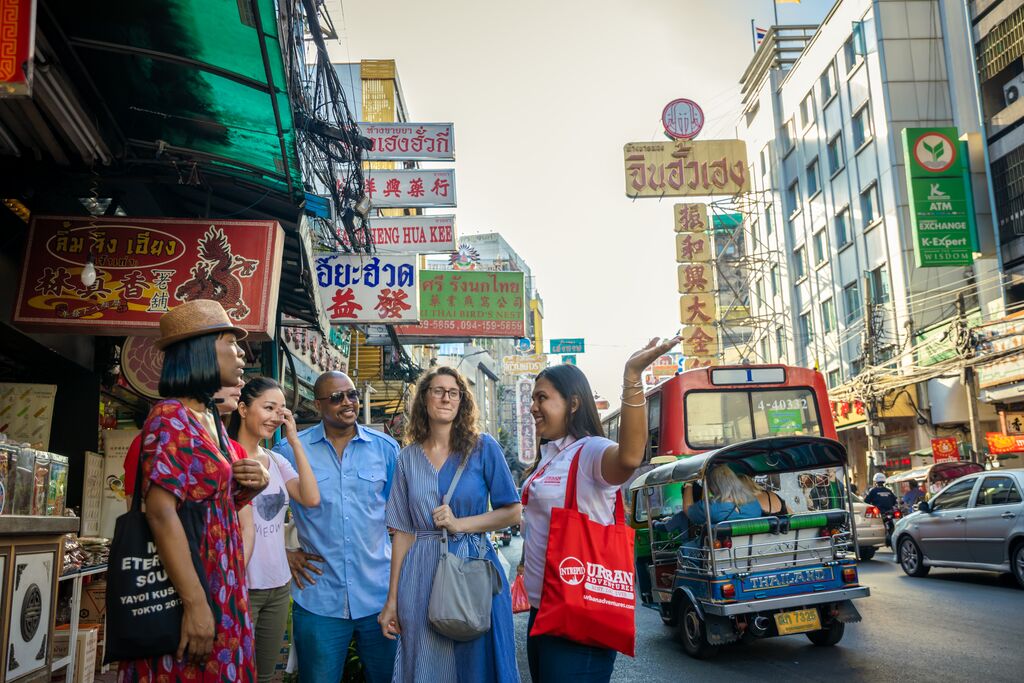
Whilst Chinatown is mentioned in many guides to Bangkok, it very often gets overlooked by visitors. Perhaps they feel it’s not uniquely Thai, or they have a Chinatown in their own city. Trust us, there’s no Chinatown in the world quite like Bangkok’s Chinatown. It’s one of our favourite neighbourhoods, the heart of Bangkok’s street food scene and a fascinating part of the old city’s history.
Bangkok’s Chinatown can be assault on the senses, in a good way, but you need to get off the main Yaowarat road to explore the hidden narrow lanes and markets stumbling across shrines, temples and local entrepreneurs along the way. As you delve deeper into this historic neighbourhood, you’ll see signs of how the Thai and Chinese cultures have merged over generations and get a sense of just how important the original Chinese immigrants were to the city’s trade and commercial history.
For foodies there’s an endless choice of street food to try, and for photographers there are so many great shots of local life and hidden beauty if you know where to look. Don’t miss our favourite rice and curry stall Jek Pui curry next to Wat Mangkon for both fantastic street food and an Instagram worthy backdrop.
Bangkok’s Chinatown is best visited in the late afternoon into evening when the street food vendors set up and Yaowarat’s neon signs lights up. On the fridges of Chinatown, Soi Nana is one of the city’s most happening bar scenes so stay and make a night of it, bar hopping between the likes of Tep Bar, Teens of Thailand and Wallflowers Upstairs. Or head to Skyview 360 for one of our favourite city views, or to River Vibe Restaurant and Bar to sit by the banks of the Chao Phraya watching the boats come and go.
If you’re travelling along the Chao Phraya river to reach Chinatown, rather than getting off at Ratchawongse Pier, get off at Lhong 1919 and take a look at this Sino-Siamese heritage house which has murals, galleries and boutique shopping first then use the local ferry to cross over to Chinatown.
With the recently opened MRT line extension you can now get off at Wat Mangkon station right in the heart of Chinatown. The station itself is worth seeing with its location themed decorations, join the locals collecting selfies in the station, or better still download the “Recall” AR app and see the images come to life.
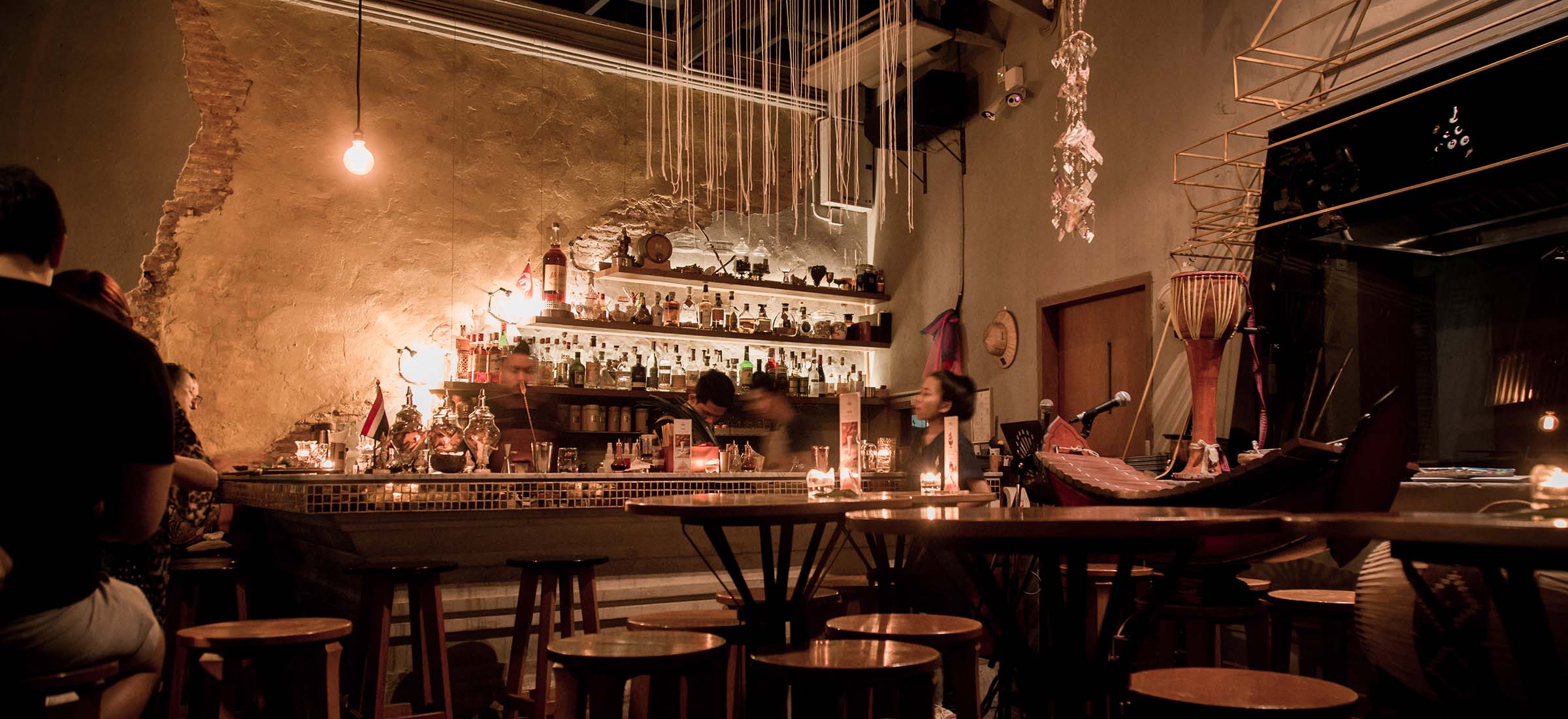
Urban Adventures and New York Times Journeys have partnered up to bring you a series of specially curated tours around the world inspired by the newspaper’s famous ’36 Hours In’ column. Our Bangkok guides worked closely with the New York Times team to design an exclusive Bangkok tour that showcases the very best of what the city has to offer. You’re invited to go behind the scenes access at Mae Prapa shop, one of the oldest and most famous makers of Thai crispy pancakes for a private tasting, taste Thai herbal cocktails, listen to traditional Thai music in a contemporary bar and there’s even an exclusive chance to practice mindfulness techniques with an expert Buddhist monk. Book your Bangkok’s Hidden History and Food Culture tour today.